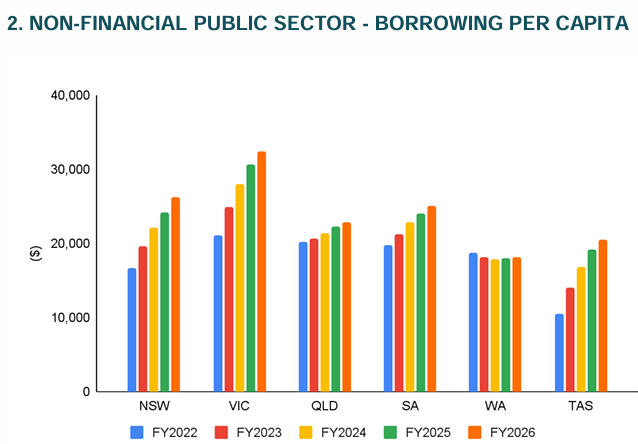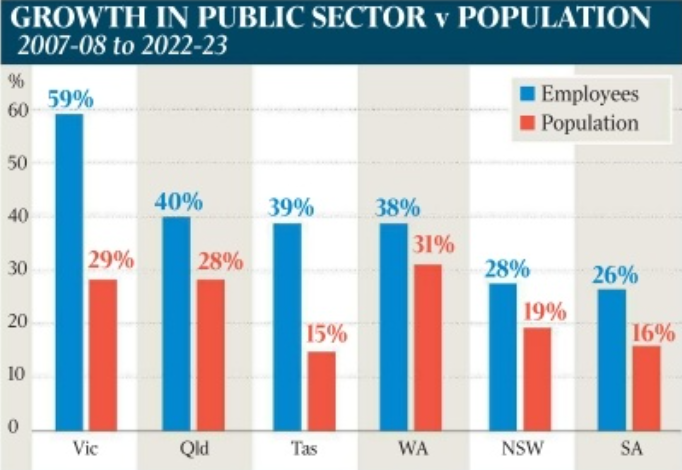The AFR reported on Friday that Victoria’s state government debt has blown out by another $11.7 billion to more than $126 billion.
Global ratings agency S&P also warned that Victoria is on track to almost double its debt by 2027 to $247.2 billion.
At that level, Victoria’s interest bill may exceed $33 million per day, more than doubling NSW’s debt, which is projected to reach $118 billion by 2025-26.
“On our measures, interest costs will soon consume more than 5% of operating revenue for the mainland eastern states”, the S&P report said.
“Interest expenses topped $14.3 billion in fiscal 2023 … deficit states will borrow merely to meet interest outlays, creating a vicious feedback loop”.
On Monday morning, I discussed the issue with Tom Elliott on Melbourne’s 3AW Radio.
Below are key highlights.
Leith van Onselen:
Victoria’s got the most debt in the country out of all state governments. We also have the lowest credit rating, and our debt is forecast to grow the fastest in the coming years by the rating agencies.

Source: Adept Economics
It has basically come about for three main reasons.
First, we’ve had a massive increase in public sector bureaucrats in Victoria. So, our public service has expanded by 59% in the past 15 years and that’s well in excess of our population, which grew by 29% over the same period:

Source: AFR
Tom Elliott:
So, in the period where our population went up 29%, our state bureaucracy went up 59%. So, more than double?
Leith van Onselen:
That’s right, according to the Australian Bureau of Statistics. Further, Victoria’s public service wage bill also soared by 152% over that same period, which was by far the fastest growth in the nation.

Source: AFR
On top of that, we’ve had massive cost blowouts in infrastructure projects. We’re all pretty familiar with those.
For example, the Northeast link was estimated to cost $15.8 billion. It’s now going to come in at $26 billion. We’ve had that across the board.
The Allan Government just signed a the first contract for the $200 billion Suburban Rail Loop against expert opinion, which is going to lump on more debt and cost.
Then obviously, we’ve had the pandemic fiasco, where Victoria was the most locked-down state and we ran up huge debt.
So the upside of this is we’re going to have more taxes and more fees and charges on anything they can charge us with. And then they’re going to be cutting back on essential services.
Tom Elliott:
What sort of taxes can we look forward to? We’ve already had a surcharge on land tax, for example. Can we expect more of that?
Leith van Onselen:
Yeah, that sort of stuff. Also, the state government effectively put a tax on private school fees last year when it raised the payroll tax and applied it to private schools.
It’s just those sorts of things. All sorts of little charges, such as when you try and renew your license, they’ll probably try to jack up that. You’ll see it left, right, and centre.
The solution to this is to cut back on their bureaucracy, but they probably won’t do that.
Tom Elliott:
I spoke on air with the Premier two months ago. I asked her about cost overruns on the big infrastructure projects. She always described them as extra investments.
Therefore, if something was due to cost $20 billion and instead of cost $40 billion, that’s okay because it’s an extra investment.
With that sort of thinking, maybe it’s no wonder that debt is going through the roof.
Leith van Onselen:
It’s sort of the broken window fallacy, it’s kind of stupid.
So if your cost goes up, according to the Premier, that creates extra economic activity because you’re employing more people for longer. And you’re spending more.
But that’s kind of ridiculous. Imagine if we run our household budgets like this?
I do have some sympathy for state governments and Victoria.
The federal government collects most of the tax revenue in the country. They collect about 80%. They’re fire hosing record numbers of people into Victoria and New South Wales. And that’s leaving the states exposed because they have to provide most of the services and most of the infrastructure.
So, it is also the blame of the federal government. But obviously, the fact that Victoria is worse than New South Wales means that we’ve got gross mismanagement down here.
Tom Elliott:
So, we’ve got the pandemic debt that was badly managed, but it can’t be undone.
You’ve got growth in the public service that could be wound back, but it’s heavily unionised. It supports the government. So you know they’ll probably go softly softly on that.
Then you’ve got cost overruns on big infrastructure projects. Surely, the Suburban Rail Loop, which some people say could cost as much as $200 billion, surely that needs to be axed or iced or put on hold for the time being?
Leith van Onselen:
100% it should be. Just about every infrastructure expert panned that project and advised the government not to go ahead with it.
Yet, the premier late last year signed the first contract of about $30 odd billion for the first stage.
So, unfortunately, she’s locked us into this ridiculously poor infrastructure project that doesn’t pass any cost benefit analysis. And it’s going to cost a lot of money. It’s going to plunge us more into debt.
The problem with that is it means that if we are spending more money on that project, we’re going to have less money to spend on genuine infrastructure projects. We’re going to have less money for hospitals, schools, and all those sorts of things.
This means we’re going to get poorer services, and that’s why we’re seeing vital programs like this homelessness program getting cut back.
Just one final point there: why is the government slashing funding for homelessness when it’s just paid top bureaucrat Jeroen Weimar over half a million dollars to lead the government’s housing policy in the Departments of Premier and Cabinet.
The government should be cutting back on that bloat in the public service, I would have thought?

